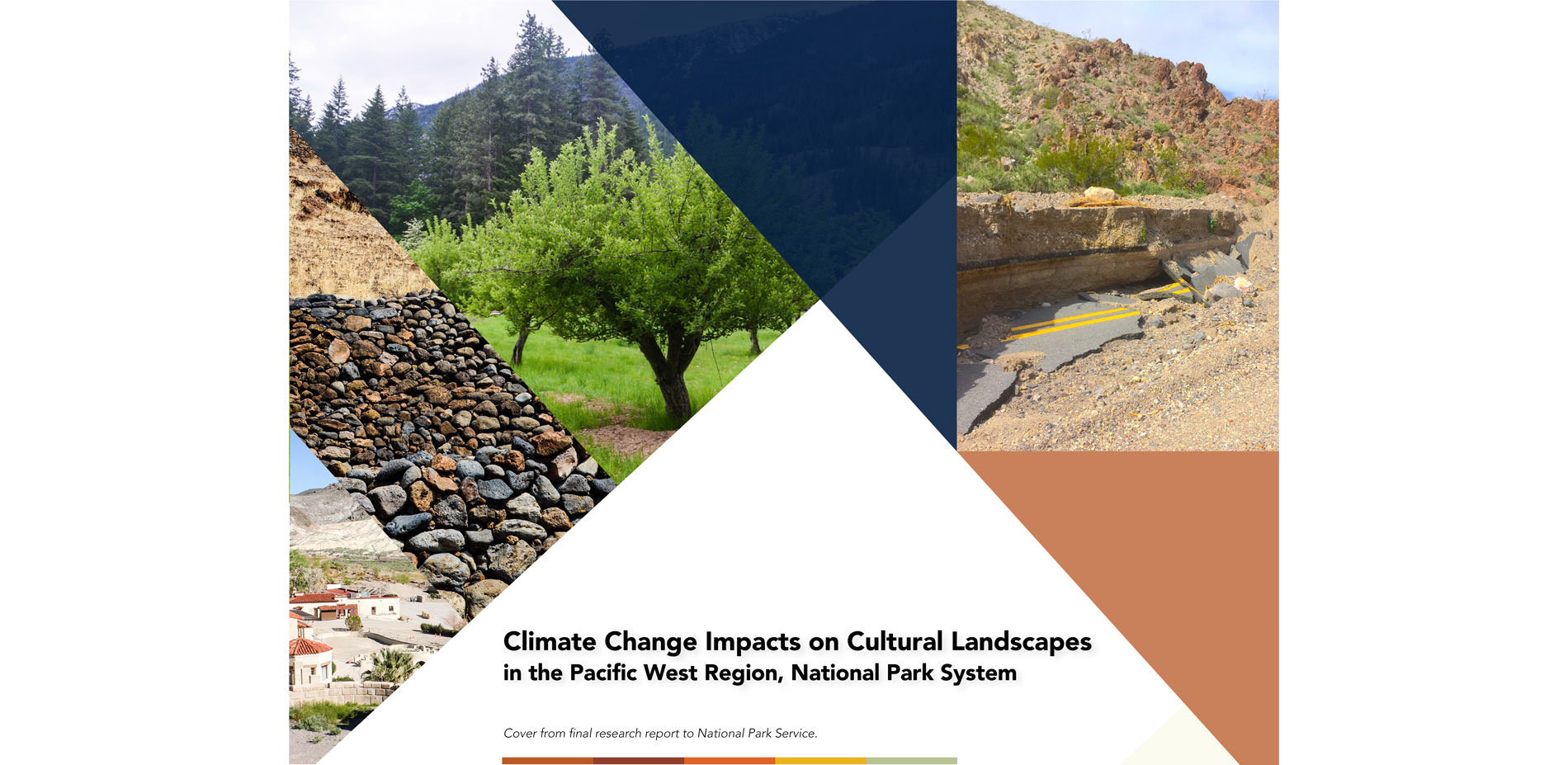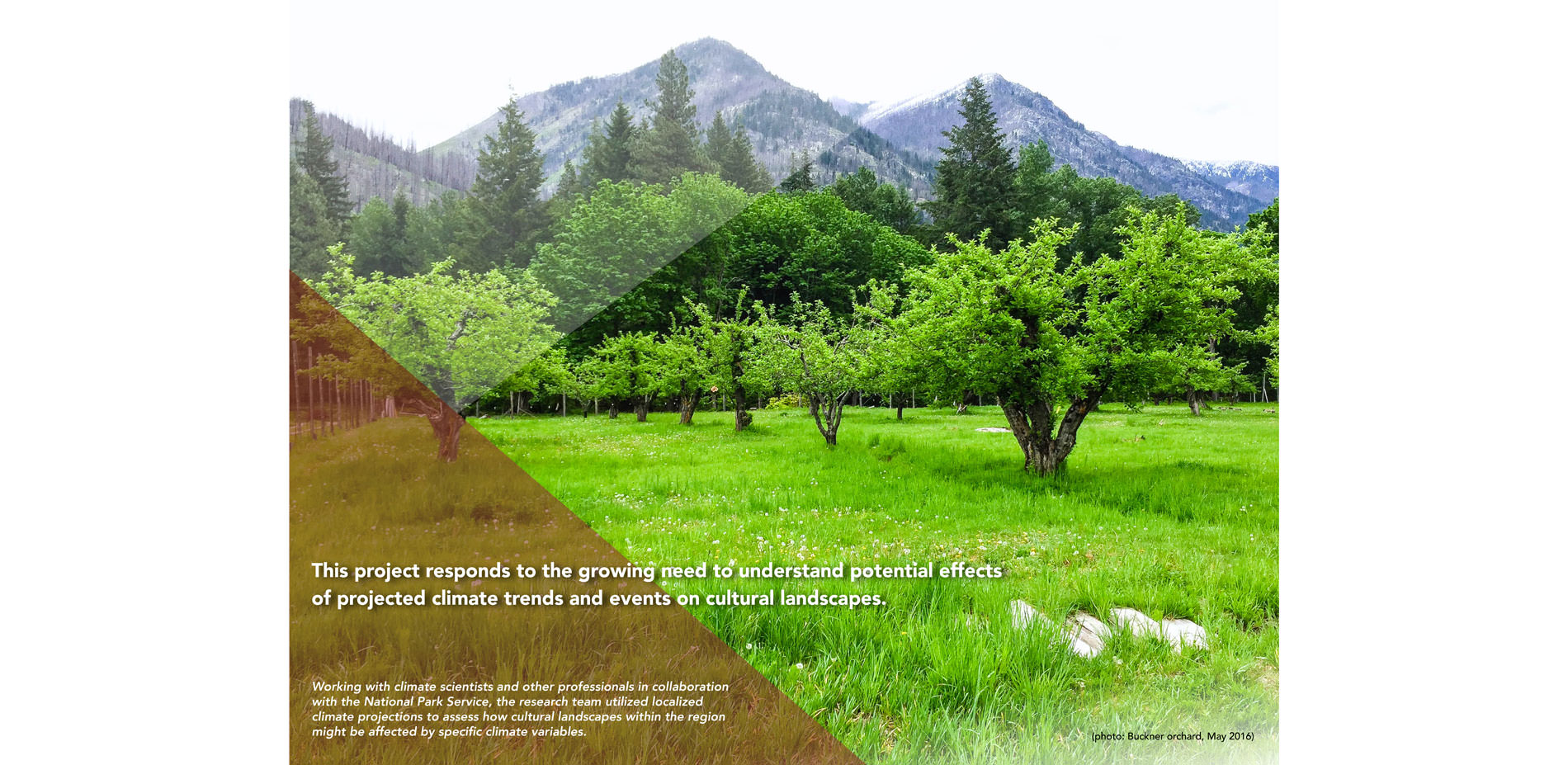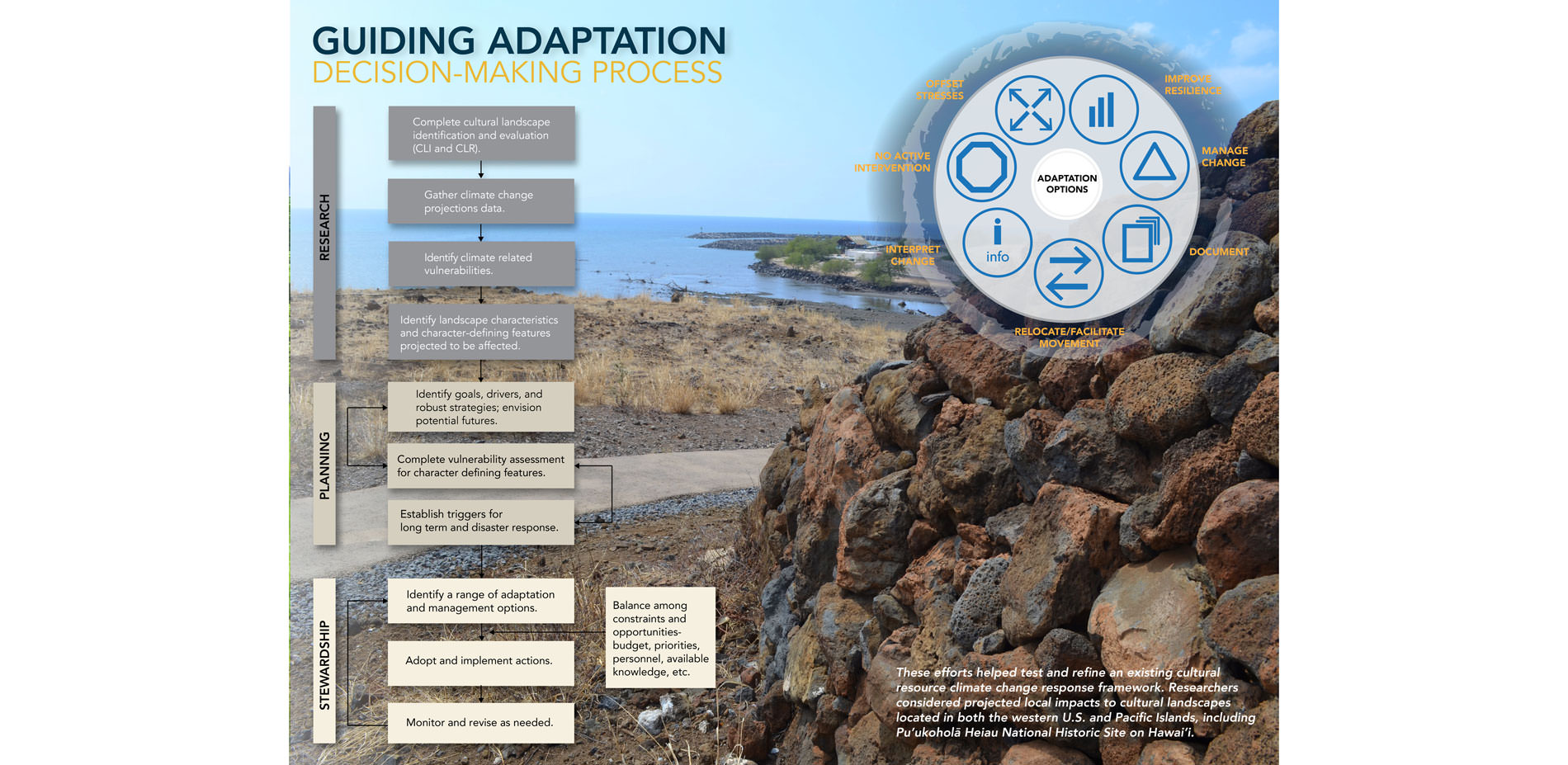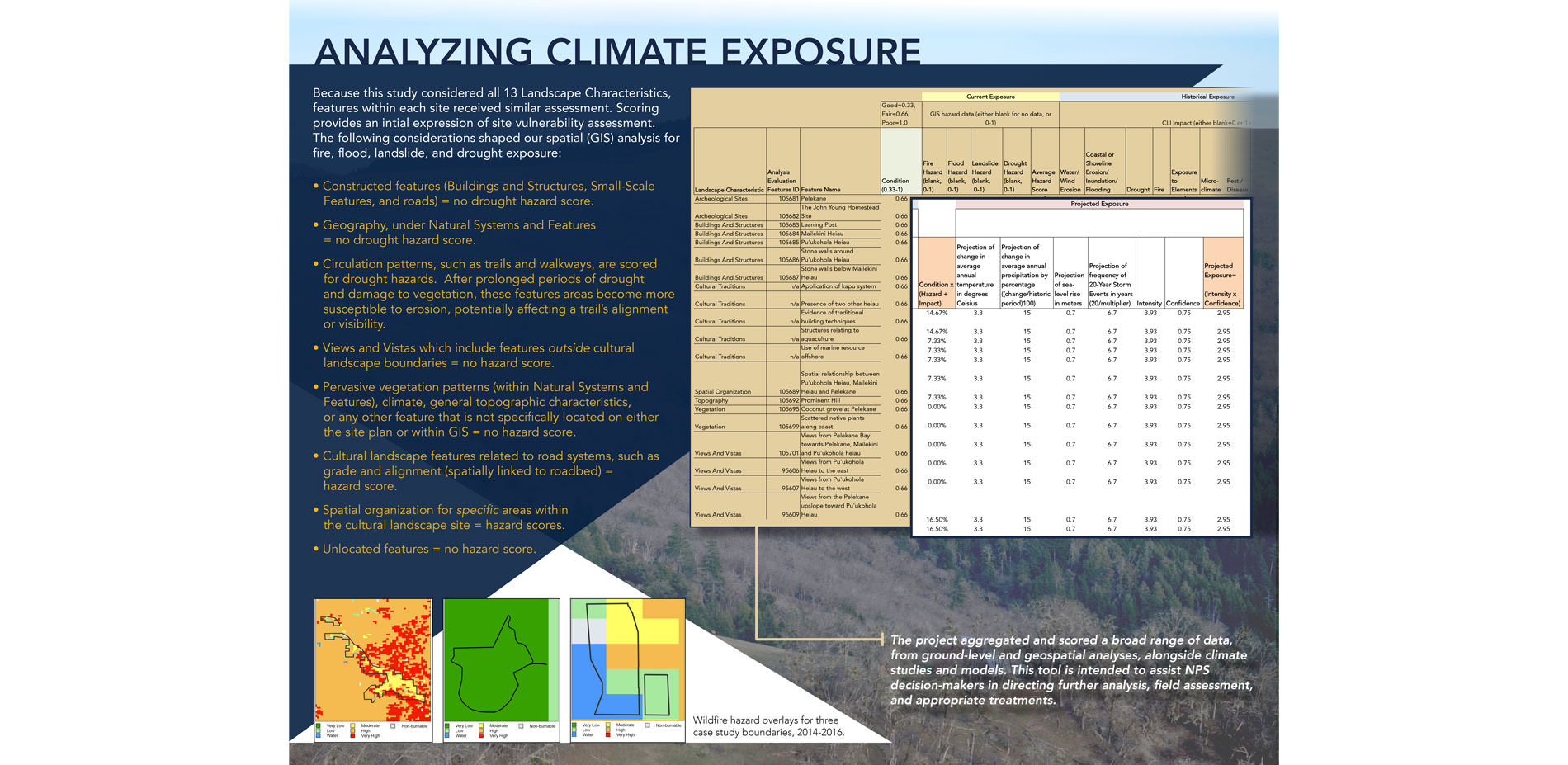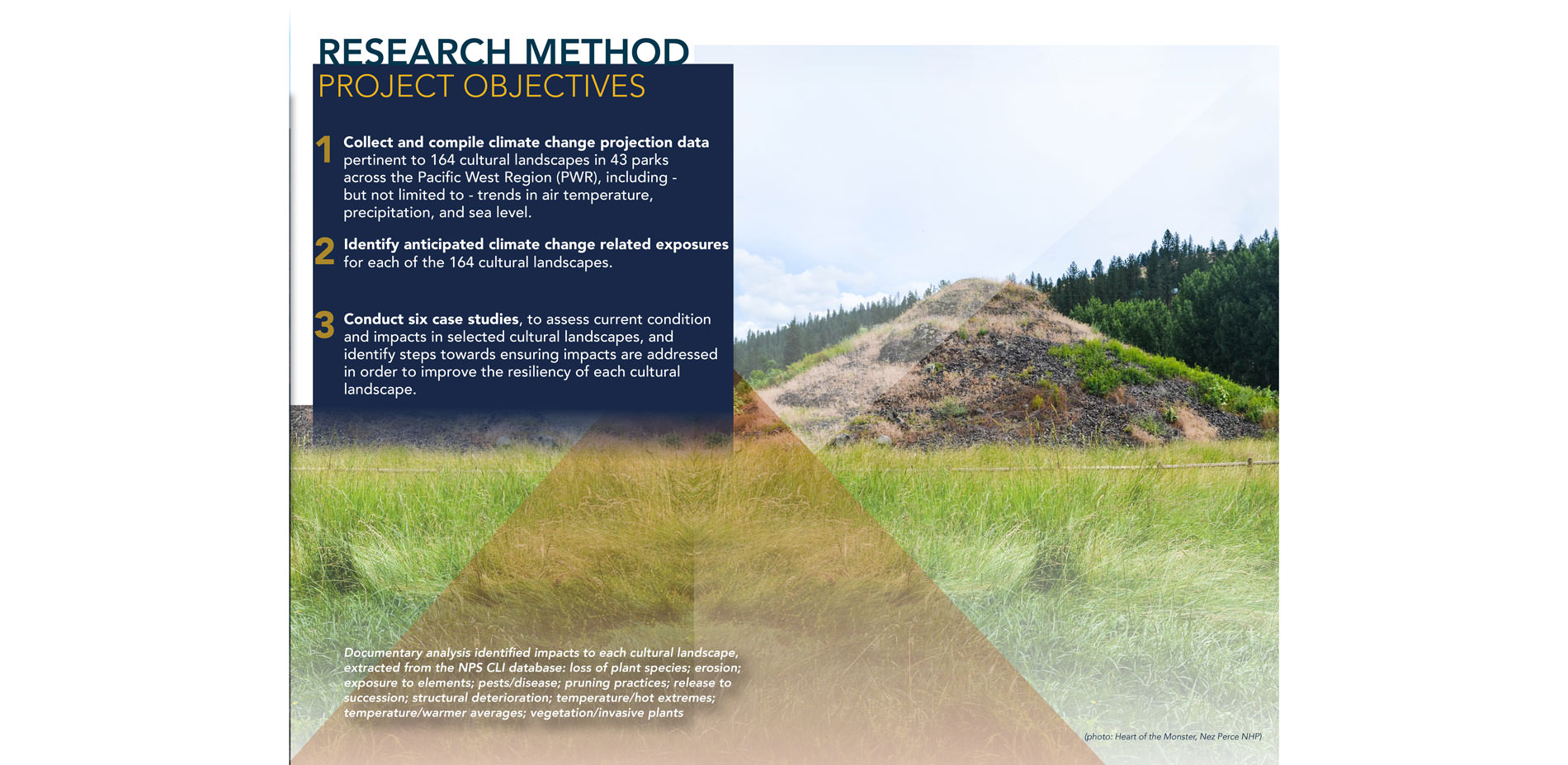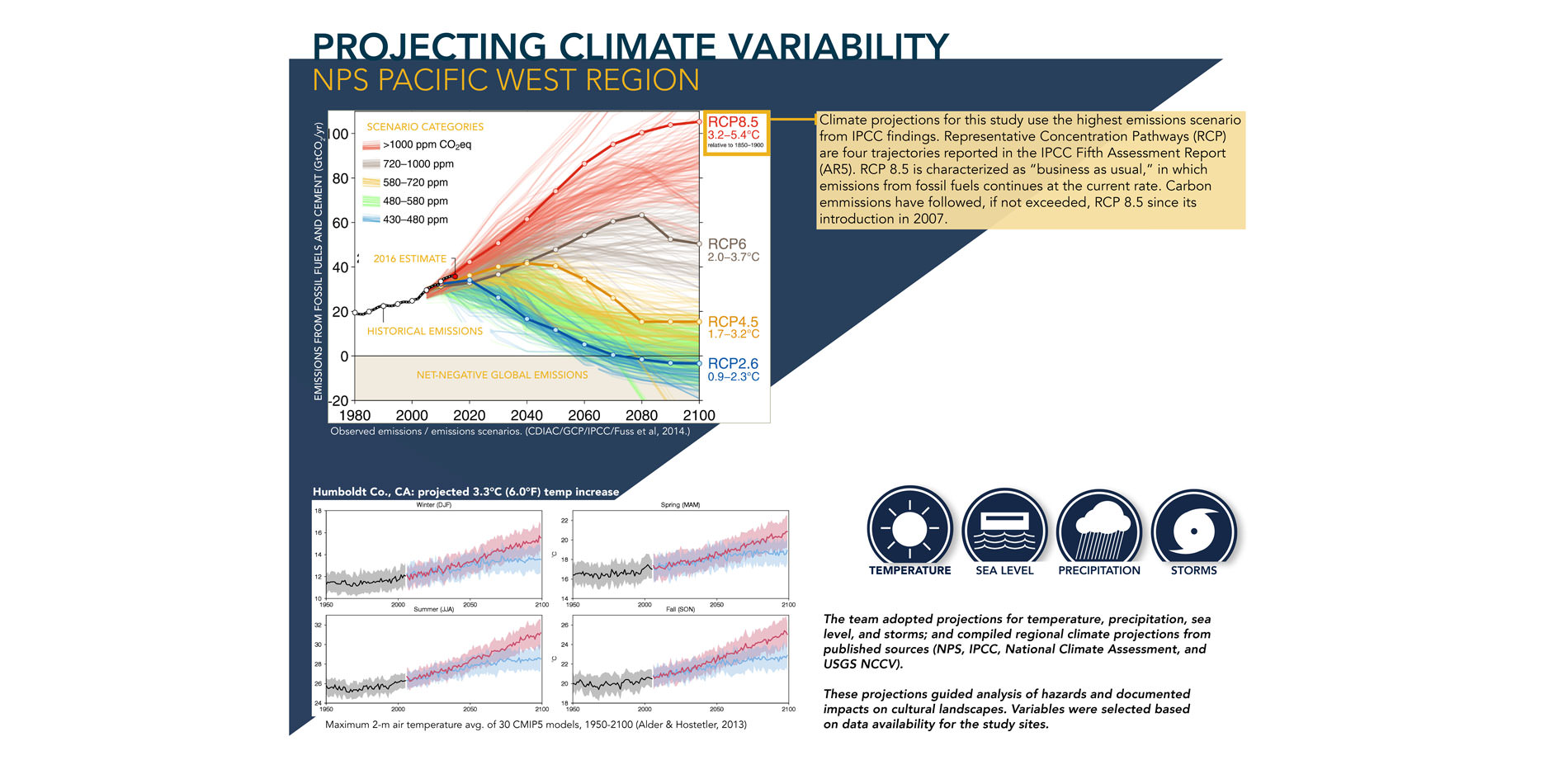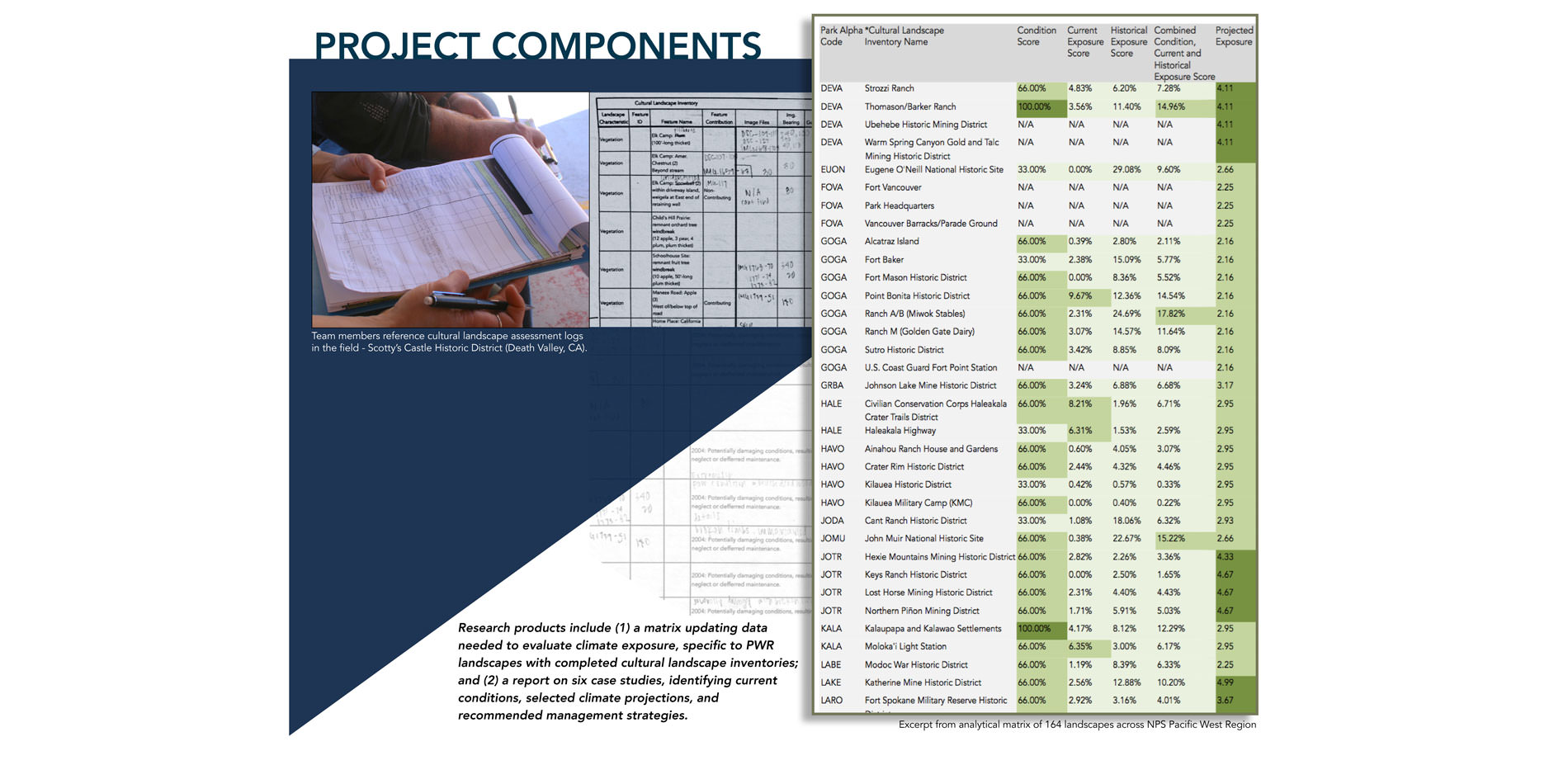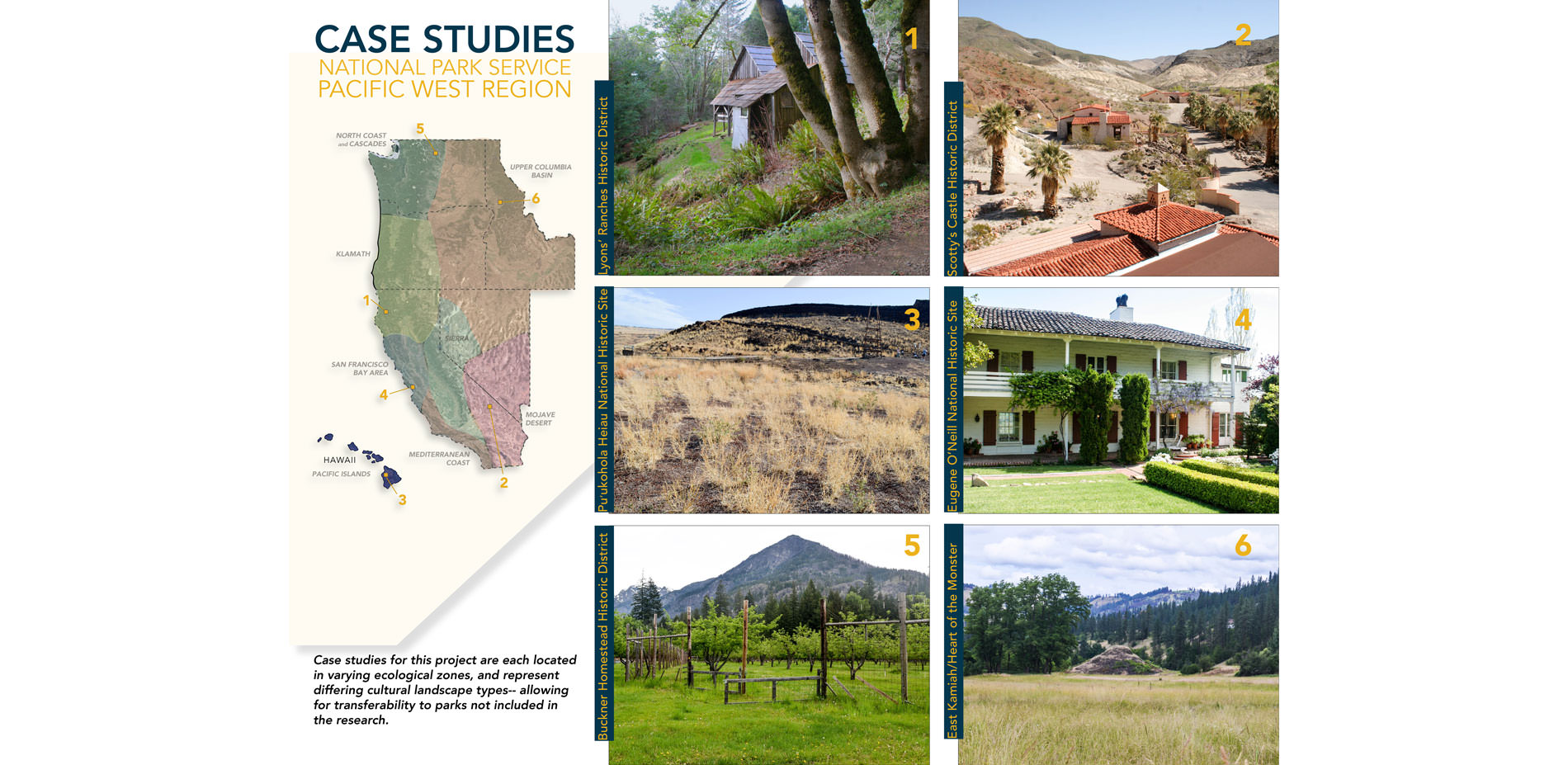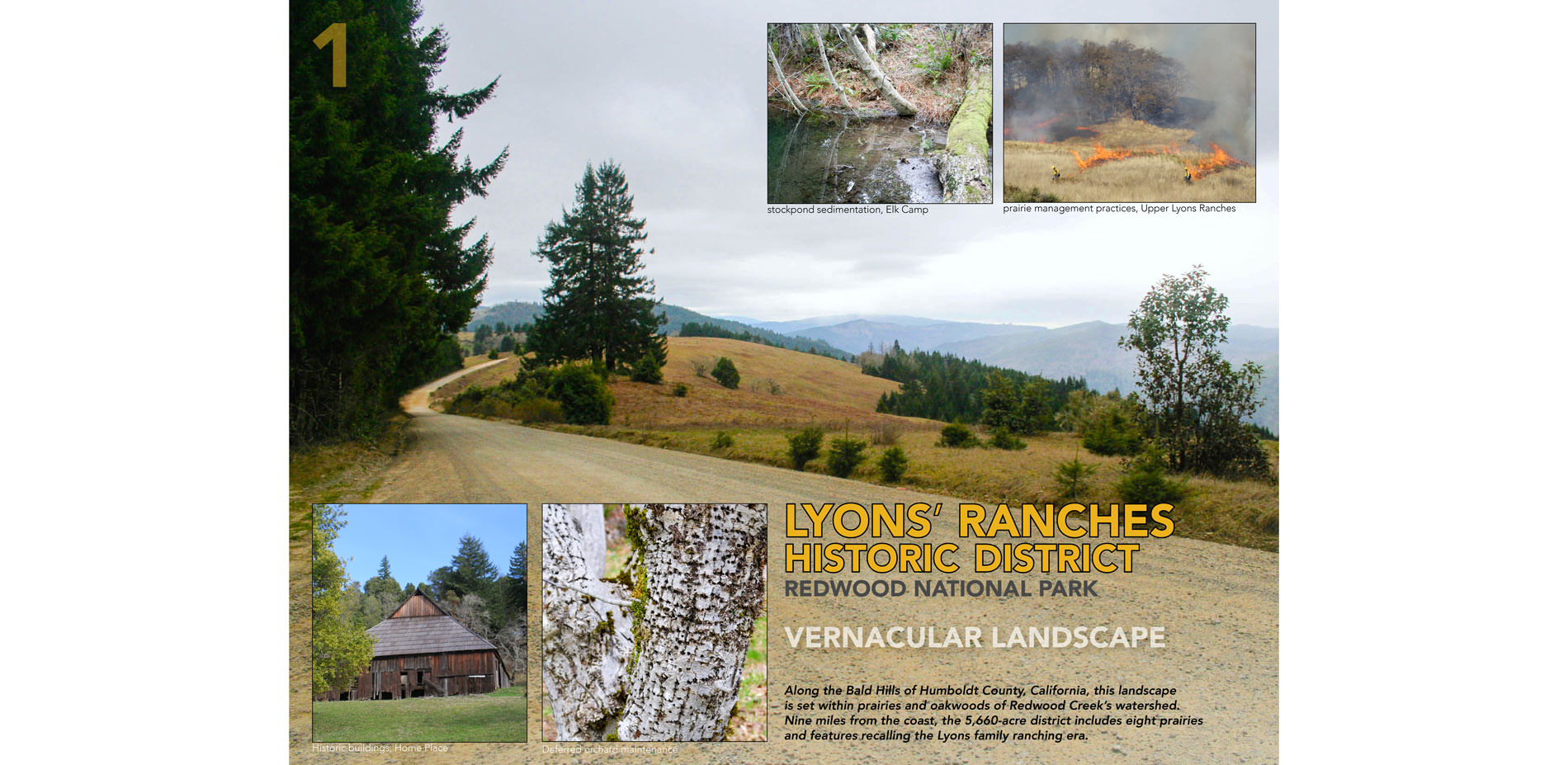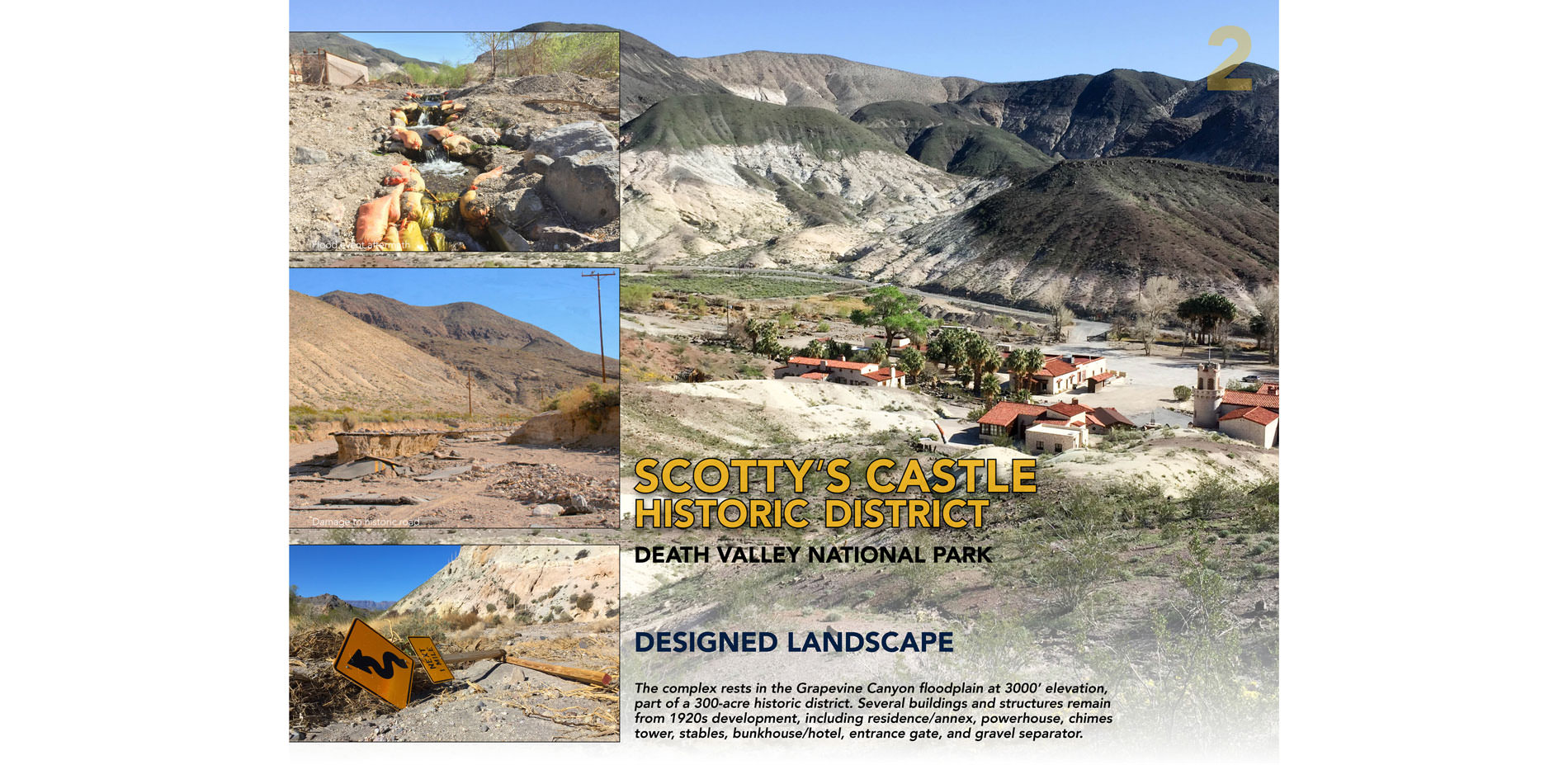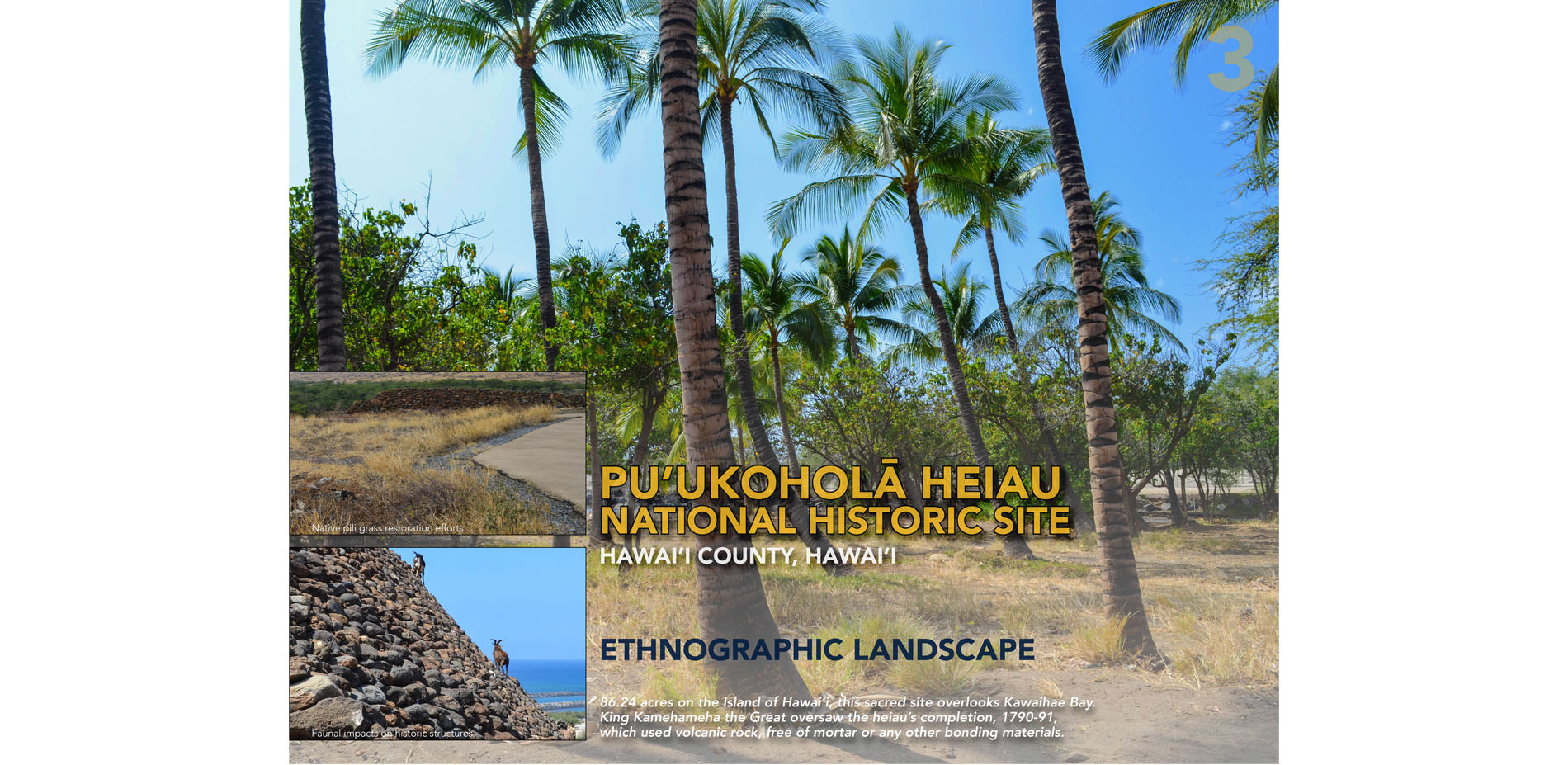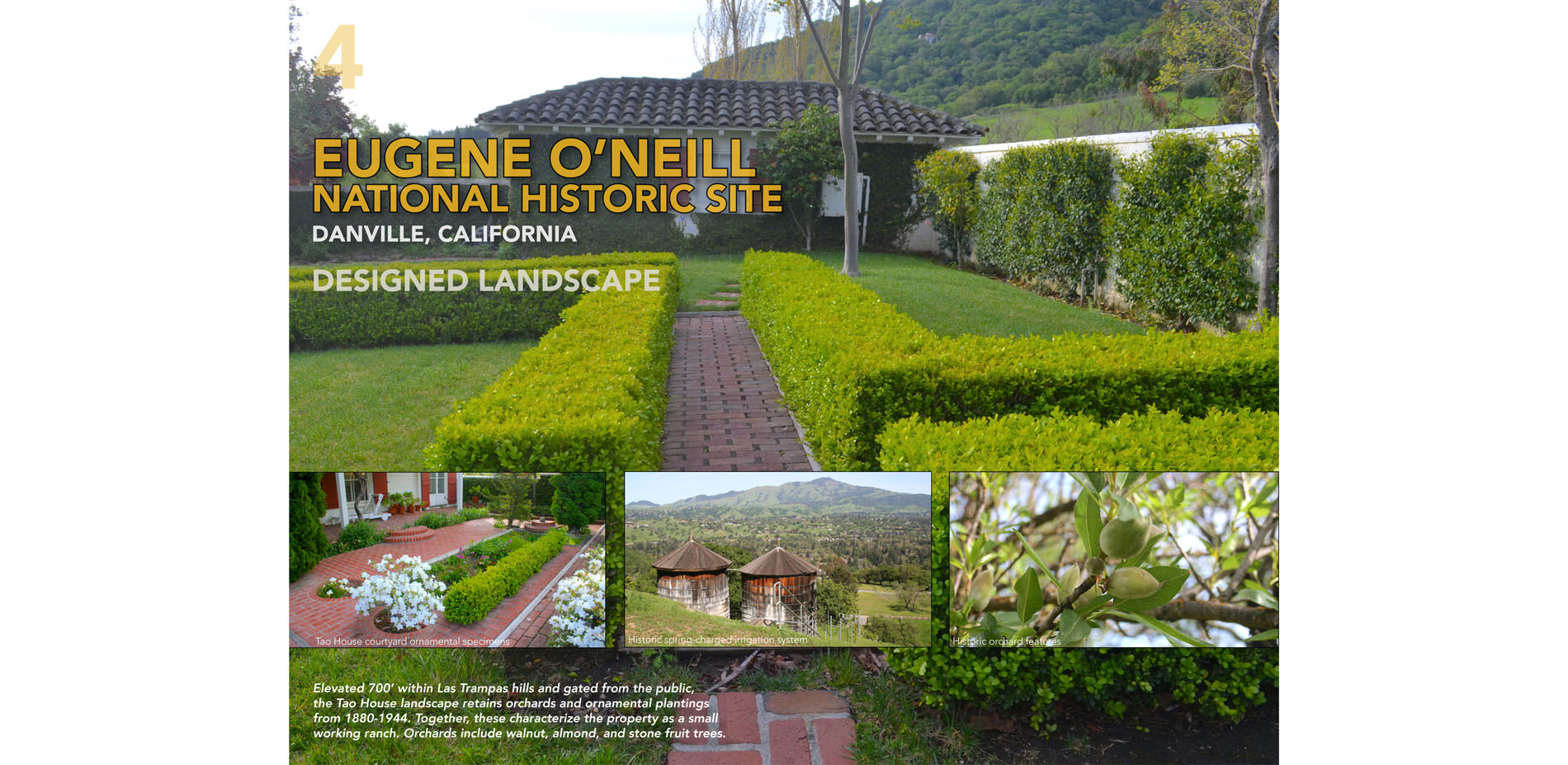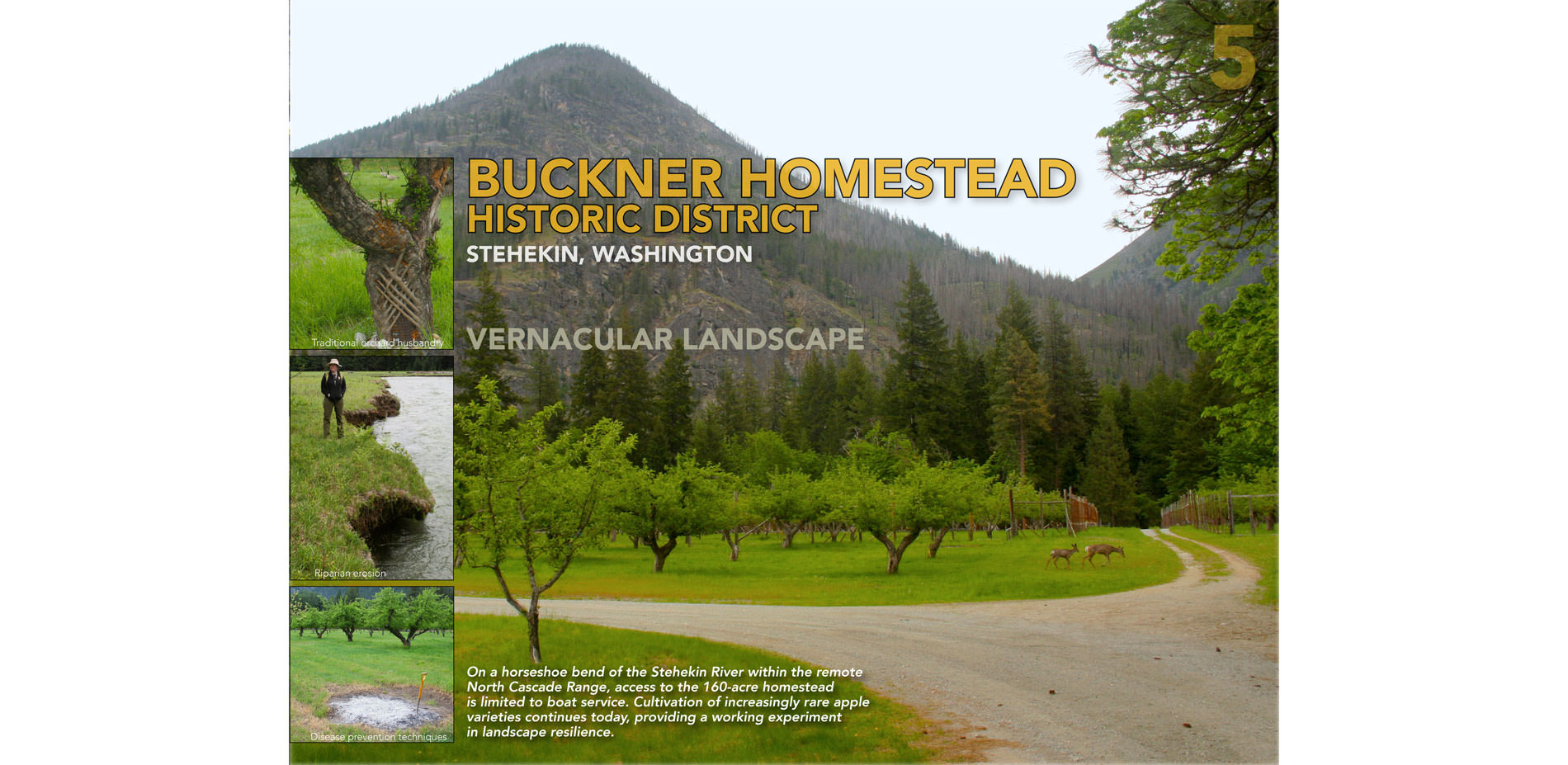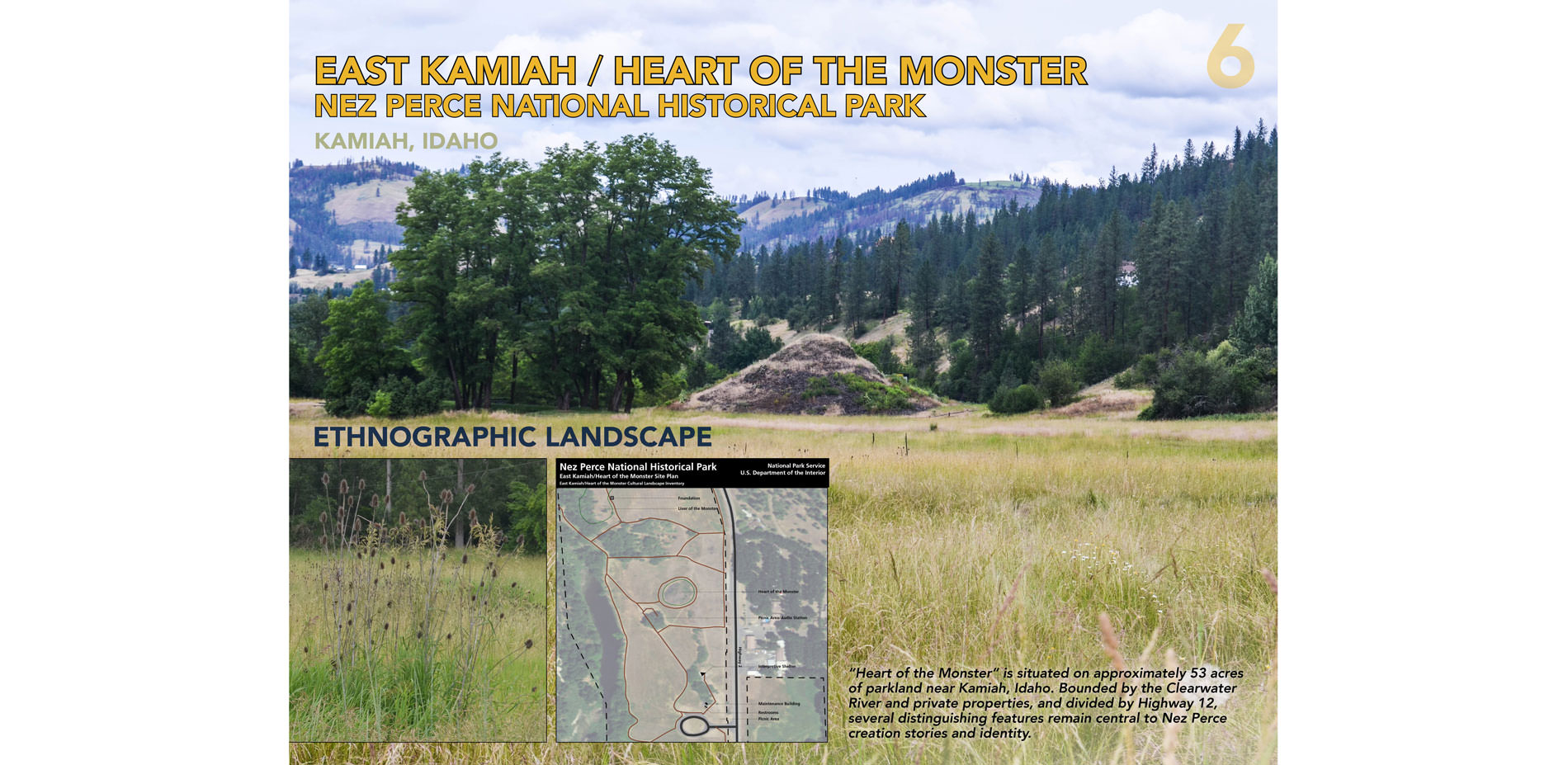Climate Change Impacts on Cultural Landscapes in the Pacific West Region, National Park System
Honor
Research
Eugene, OR, USA | Cultural Landscape Research Group, University of Oregon | Client: Pacific West Region, National Park Service
A very good model for assessing a broad range of properties and sites in regard to climate change and adaptability.
- 2017 Awards Jury
PROJECT CREDITS
Lead Researcher:
- Robert Z. Melnick, FASLA;
Research Team Members:
- Veronica Malinay, Associate ASLA; Noah P. Kerr; Alison Lewis, Associate ASLA
PROJECT STATEMENT
The study of climate change impacts on cultural landscapes in the Pacific West Region (PWR), of the National Park System, assessed how these landscapes might be affected by key climate variables, and developed recommendations for future research toward the agency’s goal of ensuring cultural landscapes’ resilience in light of climate change variables.
Products of this research include a matrix designed to update and organize data needed to evaluate the exposure of inventoried cultural landscapes in the Pacific West Region; and a report describing six case studies, which identifies current conditions, projected climate variables, and recommended management strategies to address current condition needs and areas of future research.
The matrix compiles all character-defining features and environmental impacts documented for 164 cultural landscapes across the region, including exposure to current environmental hazards and to projected changes in temperature, precipitation, and sea level.
Each case study includes summaries of cultural landscape characteristics, regional climate change projections, existing conditions (field survey), hazard exposure (GIS) analysis, and recommendations for next steps.
PROJECT NARRATIVE
The study of climate change impacts on cultural landscapes in the national parks of the Pacific West Region (PWR), responding to the growing need to understand potential effects of projected climate trends and events, was conducted in collaboration with the National Park Service. Working with climate scientists and other professionals, the research team utilized localized climate projections to assess how cultural landscapes within the region might be affected by specific climate variables. Research informed recommendations for future research toward the agency’s goal of ensuring cultural landscapes’ resilience in the era of climate change.
Products include (1) a matrix to organize data, to assist in evaluating climate exposure specific to PWR landscapes with completed cultural landscape inventories; and (2) six case studies, including identification of current conditions, selected climate variable projections, and recommended management strategies to address current conditions and areas of future research.
The matrix summarizes all character-defining features and documented impacts for 164 cultural landscapes across the region. Summarizing exposure of these features to known environmental hazards and key projected climate changes, the matrix includes a model used to score each cultural landscape feature, enabling future comparisons between sites’ exposure to both current risk and projected climate change.
Each case study summarizes cultural landscape characteristics, selected climate change projections, existing conditions, and exposure hazards. They include recommendations for responsible stewardship.
Cultural Landscape Inventory and Climate Adaptation Strategies
The Cultural Landscapes Inventory (CLI) is a certified database of all significant landscapes in the National Park System. CLI’s document the conditions of cultural landscapes, including known impacts. In this project, both condition and impacts for each cultural landscape were analyzed regarding current climate change projection data, identifying and potentially quantifying anticipated climate change impacts through the existing stewardship framework of the CLI.
Partnering with NPS, the team refined the cultural resource climate change response framework, analyzing projected climate change impacts to cultural landscapes located in the western United States and Pacific Islands. Case studies identified current cultural landscape conditions, including how each condition could exacerbate potential effects of projected climate change.
PROJECT OBJECTIVES
Collect and compile climate change projection data for 164 cultural landscapes in 43 parks across the Pacific West Region, including, but not limited to, climate change trends in air temperature, precipitation, and sea level.
Identify anticipated climate change related exposures specific to each of the 164 cultural landscapes.
Conduct six case studies, assessing current condition and impacts in selected cultural landscapes, and identifying steps towards ensuring impacts are addressed, to improve the landscape’s resiliency.
METHODS
This project tested and refined an existing framework for managing the projected effects of climate change, in a new cultural landscape format. For each landscape, the basic formula for determining vulnerability to climate variables is:
(exposure + sensitivity) / adaptive capacity = vulnerability
Climate Projections
Due to the availability of data for study sites, the team primarily considered projections for temperature, precipitation, and sea level, compiling regional climate projections from a variety of peer-reviewed sources.
Hazards
Geospatial analysis evaluated hazards associated with projections. Hazards include drought, fire, flood, and landslide—derived from established risk data published by NOAA, USGS, and USFS.
Impacts
The team analyzed documented impacts to each specific cultural landscape, extracted from the CLI database, including disruption; loss of plant species; erosion; exposure to elements; neglect; pests/diseases; pruning practices; release to succession; structural deterioration; temperature/hot extremes; temperature/warmer averages; and vegetation/invasive plants. Impacts are tracked by NPS for all cultural landscapes. For case study, each impact was verified and documented in the field.
Vulnerability Assessment Matrix
The newly designed vulnerability assessment matrix models exposure of character-defining cultural landscape features, according to climate change projection data. Exposure describes “the presence of people, livelihoods, species or ecosystems, environmental functions, services, and resources, infrastructure, or economic, social, or cultural assets in places and settings that could be adversely affected” (IPCC 2014), amended here to frame how climate change might adversely affect the cultural landscape features. The matrix aggregates and scores a broad range of data, including ground-level and geospatial analyses, alongside climate studies and models. This tool is intended to assist NPS decision-makers in directing further analysis, field assessment, and appropriate treatments. There were four major criteria included in the scoring system within the matrix: condition, current exposure, historical exposure, and projected exposure.
Condition: an overarching, landscape-scale assessment of condition, including interpretation of status described in the CLI. Current Exposure: a spatially-specific identification of cultural landscape features at risk to a climate hazard. This assigned value includes current geo-spatial (GIS) data.
Historical Exposure: identification of known current and historical impacts, primarily through CLI analysis. Projected Exposure: a calculation of intensity and confidence of climate projection data. Datasets are comprised of current climate projections by county, and by park scale (where available).
Intensity: estimated magnitude of climate change per climate variable.
Confidence: range of certainty/uncertainty in the climate change projections.
Case Studies
Six case studies were selected using three criteria: each is located in a different Pacific West Region eco-region; all cultural landscape types were represented (i.e., historic site, vernacular, design, ethnographic); park staff were available to participate and assist with fieldwork and research.
Case study sites: Lyons Ranches Historic District, Redwood National Park (CA); Scotty’s Castle Historic District, Death Valley National Park (CA); Eugene O’Neill National Historic Site (CA); Buckner Homestead, North Cascades National Park (WA); Pu’ukohola Heiau National Historic Site (HI); Heart of the Monster, Nez Perce National Historical Park (ID).
Team members analyzed the Cultural Landscape Inventory for each site and retrieved climate projection data from a variety of published and available data sources. This process shaped a determination of potential climate stresses and impacts on identified cultural landscape characteristics and features. Consultation with NPS regional and park staff enabled data sharing, collecting additional observations, and gathering new recommendations for current literature and primary source materials, as well as inviting further staff advice. The process included both quantitative and qualitative data.
Case studies included field investigation and documentation of each site with regional and park staff, and gaining a better understanding of current impacts at work in contributing cultural landscape features. This further helped clarify opportunities for future studies of attribution of known impacts to climate change. Fieldwork, including visual inspection of landscape systems, topography, vegetation, buildings, structures, and other landscape features to assess and document condition and impacts, offered insights into park priorities, competing demands for staff expertise and funding, and the acknowledged gaps in available historical and projected climate data.
RESULTS
This study produced a matrix within which each cultural landscape contributing feature was assigned a “Current Exposure” score, which was informed by the GIS spatial data, a “Historical Exposure” score, informed by the CLIs and a “Projected Exposure” score, informed by the projected climate data on temperature, sea level, and precipitation. These categories identify which features (and by extension, how many features) have a high exposure to climate related trends and events.
FURTHER RESEARCH
As this research primarily addressed one piece of the equation, exposure,future research is underway to address the sensitivity and adaptive capacity of each contributing feature. The next phase includes vulnerability assessments for selected cultural landscapes and preparation of adaptation strategies for selected cultural landscapes that are identified as highly vulnerable.
The next phase of our research addressing vulnerability is exciting. As landscape
architects we see a clear transferability of this framework beyond NPS. As cultural landscapes play a role within the profession, this research informs how we may take steps toward identifying places exposed to climate change and potential mitigation strategies to protect them.
